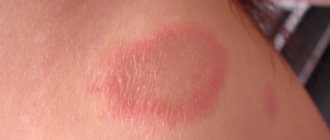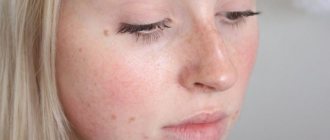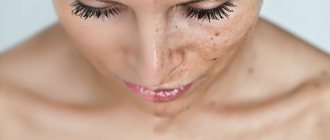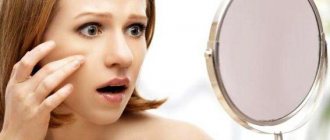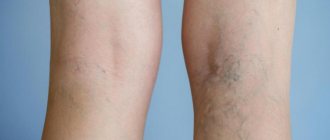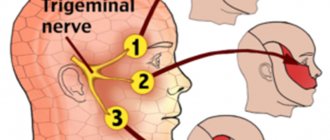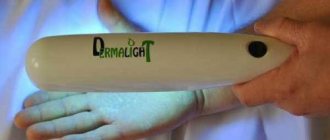Causes of age spots on legs
The spot on the leg may be a mole or freckle. Increased pigmentation of the lower extremities is the result of melanin accumulation. And if it appears under the influence of ultraviolet radiation, then this is perhaps the safest cause of hyperpigmentation of the legs. Dark spots can also appear as a result of ruptured capillaries. In this case, the area is small and does not require therapeutic measures. In other cases, the causes of pigmentation on the legs or groin lie in one or another pathology. Below is a list of diseases that can cause skin pigmentation on the legs.
- Vascular lesions as a result of diabetes, atherosclerosis and varicose veins.
- Neurofibromatosis. This is the name given to numerous inclusions of a milky-brown hue. They appear for genetic reasons.
- Chronic dermatitis. It is caused by wearing tight clothing, allergies to cosmetic products, fabrics. Stasis dermatitis develops as a result of varicose veins of the deep veins. Areas of darkening on the skin itch, become rough, and become rough.
- Dark areas may appear due to cirrhosis or fibrosis of the liver tissue.
- A dark spot on the skin may be a sign of developing carcinoma. Melanomas on the sole are especially dangerous.
- Some pathologies of the cardiac and vascular system can cause brown spots on the skin of the legs.
- The skin also darkens with vitamin deficiency - a lack of B vitamins.
- If redness appears in the area of the little finger or thumb, then this is the first sign of the development of psoriasis. With this disease, pink or reddish pigmentation appears on the feet and ankles.
Age spots on women's legs
Some women may experience brown spots on their legs while pregnant. The cause of pigmentation on the legs is hormonal changes. After childbirth, skin color returns to normal.
Interesting! Only women may experience characteristic skin changes in the form of chloasma. This is focal hyperpigmentation of the skin. There is no treatment for chloasma: all cosmetic measures are limited to reducing the intensity of skin coloring.
Age spots on the legs of men
Pigmentation on the legs in men can develop as a result of Becker's melanosis . It looks like a mole and develops most often in teenagers. In an area of increased pigmentation, increased hair growth may be observed. The cause of Becker's melanosis has not yet been clearly established. If varicose veins are left untreated, pigmentation of the legs below the knee appears in the form of pink and then red spots. In severe cases, their color changes and they become purple, almost black.
Note! The appearance of black spots indicates that a necrotic process is developing in the skin. Without emergency treatment measures (surgery), gangrene may develop.
Pigmentation of legs with varicose veins
Varicose veins spots appear if the disease has reached an advanced stage. Untimely treatment of the pathology leads to the fact that the veins become clogged with blood clots. Because of this, oxygen metabolism in the tissues is disrupted and they experience oxygen starvation. This is one of the reasons for increased pigmentation of the skin on the legs.
Important! Skin pigmentation on the lower leg and other parts of the limbs does not appear in one day. The skin turns red because blood stagnates in the legs. If varicose veins are left untreated, the skin turns brown. When trophism is disrupted, the skin becomes covered with dark areas.
Predisposing factors
- wearing tight shoes;
- constant microtrauma of the skin of the legs;
- hyperhidrosis;
- use of low-quality household chemicals.
Prevention measures
To reduce the risk of hyperpigmentation, you need to follow a few simple rules:
- avoid tanning during the period of greatest sun activity (from 12 to 16 hours);
- balance your diet, include in your diet more plant foods rich in vitamins C, B, A;
- use only high-quality cosmetics suitable for a specific skin type;
- avoid stress;
- drink enough clean water;
- normalize weight;
- do physical education;
- do not abuse depilation;
- to refuse from bad habits;
- use sunscreen not only for the face, but also for the whole body;
- wear clothes made from natural fabrics, high-quality shoes of the right size.
Do not neglect preventive medical examinations and follow all medical recommendations when treating any chronic diseases.
Pigmentation on the legs is a symptom of many dangerous pathologies. If it is detected, you should visit a doctor as soon as possible, find out the cause of the spots, and undergo the prescribed treatment. If you start therapy at the initial stages of pathology development, there is a chance to preserve not only the health, but also the beauty of your legs.
Pigment spots or peculiar freckles on the legs appear due to increased pigmentation of the skin. This phenomenon is not considered a disease, but it causes discomfort as it affects appearance. To cope with this problem, official medicine and traditional healers offer various drugs and recipes.
Types of spots on legs
There are three types of pigmented areas on the legs.
- Leucoderma . It is characterized by decreased pigmentation of the lower extremities, and the skin on the affected areas appears much lighter.
- Melasma . Darkening of the skin is characteristic.
- Blue-gray pigmentation.
These types of disorders are not independent types of pathologies. They indicate that some pathological process is occurring in the body.
- mesh;
- marble;
- spotted;
- leprosy;
- lichen;
- keratoses;
- lentigo (age spots);
- post-inflammatory pigmentation;
- warts;
- moles;
- comedones (or the so-called strawberry legs effect);
- venous stasis (in which the skin becomes dark and even purple over a large area of the leg);
- diabetic spots;
- chronic pigmentary purpura;
- petechiae, or marble hemorrhages;
- Kaposi's sarcoma (caused by herpes virus type eight).
Hyperpigmentation in children
In childhood, spots on the skin appear much less frequently than in adults, and hyperpigmentation is usually a consequence of injury to the epidermis. Rash, diaper rash, inflammation in children - all this can leave behind areas of skin that are darker than the rest of the body.
You should be wary if a rash of unknown etiology appears for no reason. This may indicate the presence of serious acquired or hereditary pathologies.
As for freckles, they can appear by the age of 3-4 years and go away with age. Freckles do not pose any health risk.
Treatment of age spots on legs
Many patients are interested in how to remove pigmentation on their legs. This can only be done after its cause has been established. Self-medication of discolored legs is dangerous and can cause burns. First of all, you need to contact a dermatologist, phlebologist, or endocrinologist. Women should definitely visit a gynecologist. The causes and treatment of pigmentation on the legs are closely related, and doctors will prescribe a comprehensive examination. After this, it will be possible to select the most effective treatment.
Treatment for hyperpigmentation consists of:
Hyperpigmentation can be removed:
- chemical types of peeling;
- laser;
- whitening creams.
Medicinal treatments
There are medical ways to get rid of hyperpigmentation on the legs. They are selected by the doctor depending on the cause of their occurrence.
- If the cause of the spots is age-related changes, anti-aging drugs with vitamins A, E and antioxidants are prescribed.
- For fungal pathologies, ointments and creams with a fungicidal effect should be used.
- If a mole has formed, it does not need to be touched. Removal of a nevus occurs only according to a doctor’s indications.
- For age spots on the legs, vitamin complexes with minerals are used.
- If the cause of the spots is varicose veins, take tablets and ointments to strengthen the veins.
- If you have diabetes, you should take antihyperglycemic drugs or insulin (Related: What can you eat if you have diabetes?).
- It is useful to take immunomodulators.
How to prevent new stains from appearing
After removing age spots (regardless of their cause), you should use all available measures to prevent ultraviolet rays from entering the skin. To do this, you need to completely avoid tanning, including in a solarium, wear a wide-brimmed hat, and light clothes with long sleeves. An anti-hyperpigmentation cream containing UV filters will be of great help. Preparations that contain whitening components (salicylic acid, hydrogen peroxide, hydroquinone, arbutin, kojic acid and others) will help maintain the results obtained.
The following drugs also have depigmenting properties:
The most popular and effective skin whitening drugs are the following:
Skin whitening preparations
- Belosalik;
- Achromin;
- Zinc ointment;
- Synthomycin liniment;
- Retinoic ointment;
- Melanative;
- Skinoren;
- Melan.
The most effective are those containing hydroquinone. However, this substance does not simply destroy the pigment, but leads to the death of the cells in which it is synthesized. Depigmentation with its help is irreversible.
Conclusion
Pigmentation on the legs indicates pathology in the body. If pigmentation appears on your legs, you should consult a doctor as soon as possible. Timely treatment guarantees a good result and the disappearance of spots.
How differently people treat their bodies. For example, some kind of pigmentation of the skin on the legs was discovered, the causes of which are unknown. What to do?
Sometimes people pay offensively little attention to some formations on the skin of their feet. This is especially true for a person who wears trousers every day. You may not immediately notice that you have developed some kind of mark. When was it formed? Yesterday? Or maybe a week ago? Who knows, it will go away on its own!
Friends, read the article further, there will be a lot of interesting things in it! And for those who want to: restore their health, eliminate chronic illnesses, start feeding themselves properly and much more, starting from today, go to this page and get FREE video lessons from which you will learn:
- The cause of infertility in modern married couples.
- How to feed a child?
- How does a piece of meat become our flesh?
- Why do you need protein?
- Causes of cancer cells.
- Why is cholesterol necessary?
- Causes of sclerosis.
- Is there an ideal protein for humans?
- Is vegetarianism acceptable?
Hello my friends! Svetlana Morozova is with you. The other extreme is excessive attention to the slightest spot, when people immediately rush to cover it up (with foundation, for example, if it is in a visible place) or burn it with iodine, brilliant green, or wipe it with all sorts of means. As a result, they only worsen the condition, causing the small spot to increase in size and begin to itch and hurt.
No one argues that you need to treat your body adequately, and therefore if some kind of spot has formed on your leg, it is still advisable to know the reasons for this.
How to remove age spots
There are several options for eliminating age spots. This may include hardware techniques, whitening with special preparations and folk remedies, or ingestion of vitamins and microelements. The treatment method will depend on the cause.
Among the hardware methods for getting rid of age spots on the legs are:
- Laser resurfacing. An effective option for combating age spots. The procedure involves destroying the cells that produce melanin. After laser treatment, the spots darken and peel, and then the skin returns to its normal color.
- Dermabrasion. The technique involves removing the top layer of hyperpigmented cells to form new ones.
- Cryodestruction. Involves freezing stains with liquid nitrogen.
- Photorejuvenation. Used for age spots on the legs. The procedure consists of a pulsed effect of light on the deep layers of the skin. Penetrating rays stimulate the production of elastin and collagen, which triggers the rejuvenation process.
- Chemical peeling. Pigment spots are treated with a chemical composition that burns the top layer of skin.
Drug treatment includes the use of special creams and ointments. Their action is aimed at whitening the skin. You can also try using improvised remedies and folk recipes, which do not guarantee the removal of stains, but in some cases help improve the condition of the skin.
To whiten the skin on the legs, products containing quinine, sanon and perihydrol can be used. They may be recommended by a cosmetologist or dermatologist after examining the spots and making a diagnosis. Products containing glycolic, alpha-hydroxyl and kojic acids have also proven themselves to be effective. Such components are available in VIGHY Idealia PRO and Depiderm correctors.
Good remedies against pigment spots on the legs include creams and ointments Achromin, Vitek, Skinoren, Eveline Cosmetics.
To whiten the skin, you can prepare ointments yourself from inexpensive products that are available in any pharmacy. Their use is not recommended without prior consultation with a dermatologist.
How to prepare whitening ointments yourself:
- Combine a spoonful of hydrogen peroxide with 3 drops of ammonia and a teaspoon of grated white soap. The foamy mass should be used to treat problem areas on the legs. You need to keep the product for no more than 10 minutes.
- Mix a spoonful of hydrogen peroxide with 2 tablespoons of boric alcohol, a spoonful of mineral water and glycine. Apply the product to the skin in the area of the spots several times a day.
- The product is prepared from a spoon of white clay, a pinch of soda and a spoon of talcum powder. A little boric alcohol is added to the mixture to obtain a viscous mass. It is applied to the spots for 15 minutes, then washed off with water, and the skin is lubricated with a nourishing cream.
Natural dye - melanin
There are two types of spots on the legs:
Vascular lesions are usually red or blue in color and are due to either vessel rupture or persistent dilatation.
Pigmentation is formed due to the abundant synthesis of melanin pigment. It is this pigment that determines our hair color, eye color and skin tone. But when its synthesis by melanocytes (the cells that produce it) is disrupted, it accumulates in the form of dark areas in various tissues.
The spots are not only dark, but also, on the contrary, very light, as if discolored. White spots are called vitiligo. They are painless, but due to the lack of pigment they easily get sunburned. They are caused by a complete absence of melanin. The reasons for them have not been precisely studied, but it is definitely a metabolic disorder, in particular in diabetes. The tendency to vitiligo is sometimes inherited.
Prevention measures
The appearance of age spots can be prevented, and for this the following is recommended:
- avoid prolonged exposure to open sunlight at midday,
- add more plant-based foods containing vitamins C and B to your diet,
- apply sunscreen according to your skin type,
- choose quality products for depilation and hair removal,
- consult a dermatologist if skin problems occur,
- wear clothes made from natural materials so that they do not chafe,
- minimize stressful situations, monitor your psychological state.
Increased pigmentation of the skin on the legs can appear at any age, and this problem can be dealt with. You should make an appointment with a specialist and undergo the prescribed tests. Following the recommendations of a dermatologist will help hide the defect and eventually remove it completely.
What Causes Pigmentation
The reasons for seemingly harmless spots are very diverse:
- Phlebeurysm. The blood in the lower extremities stagnates, various substances from it begin to permeate the surrounding tissues. If brown or red spots appear on the legs, coupled with swelling of the legs, which intensifies towards the end of the day, this is a reason to suspect that varicose veins are developing. You need to see a doctor urgently, otherwise you can wait for non-healing trophic ulcers!
- Diseases of the cardiovascular system, increased fragility of blood vessels (with a lack of rutin, for example), vasculitis (inflammation and destruction of the walls of blood vessels), congestion in the lower part of the body also cause unsightly marks.
- Diabetes. Due to poor tissue nutrition, red spots appear on the legs; over time, they undergo changes and become pigmented and brown. The mechanism of their occurrence is not precisely known.
- Metabolic disease. A lack of vitamins A, C, PP can cause brown spots, and a lack of B vitamins, on the contrary, can cause light spots.
- Overweight. Extra kilograms, and sometimes tens of kilograms, increase the load on the legs and their vessels, congestion occurs, substances are effused into the surrounding tissues, and spots form in these places.
- Pregnancy is, in fact, a combination of reasons 4 and 5: metabolic disorders caused by hormonal changes in the body of the expectant mother and excess weight, which overloads the vessels of the lower extremities.
- Injuries. Pigment marks leave behind burns. They can also occur at the site of abrasions. Cuts from shaving your legs or injuries from poor-quality depilation can also trigger improper melanin synthesis. Tight clothes (tight trousers, especially if you sit in them for a long time and motionless, for example at work) impede normal blood circulation in the legs and compress the blood vessels, which again leads to congestion.
- Long-term chronic diseases of the liver, thyroid gland, adrenal glands, kidneys can also cause infiltration of various pigments on the skin of the hands and feet, even on the face and around the eyes.
Other causes of skin pigmentation on the legs:
- Allergy to cosmetics. When using low-quality lotions or depilatory products, a persistent allergic reaction may occur.
- Excessive sweating in some areas almost always leads to pigmentation of the heavily sweated areas. This also includes foot hyperhidrosis - profuse sweating of the feet.
- Reaction to irradiation with ultraviolet, x-ray and infrared radiation. With an abundance of ultraviolet radiation, so-called photoaging develops. It is expressed, first of all, by the uneven distribution of melanin in the skin.
- Age-related changes. We have all seen grandmothers whose arms and legs are completely covered with “freckles,” which they never had in their youth. Starting at age 50, skin cells gradually lose their ability to interrupt pigment production. This does not happen to everyone in the same way; there is a hereditary predisposition.
Traditional medicine recipes
Traditional medicine suggests using natural bleaching agents. The most famous and accessible include pomegranate, cucumber, lemon, aloe, parsley, dandelion, and birch sap. These ingredients are combined with each other and used to eliminate age spots.
Known folk remedies for combating freckles on the legs:
- Lemon juice is mixed with castor oil. The mixture is applied to hyperpigmented areas and left until completely dry. The skin is then washed and moisturizer is applied. This recipe will help not only remove blemishes, but also tighten the skin.
- A few tablespoons of kefir are added to the cucumber juice. The mask is applied to the skin of the feet and washed off after 20 minutes. To get a good result, you should use slightly sour kefir.
- Cucumber juice is mixed with chopped parsley. Rub the skin on the legs with the product 3 times a day. For better effect, you can add a couple of drops of lemon juice.
- Lemon juice is combined with beaten egg white. The mask is left on the skin until dry. Residues are removed with a damp cloth.
Reference! For better results, folk remedies can be combined with taking vitamin complexes. This is especially effective in the fight against senile spots that appear at the age of 50 years.
What to do?
What to do if dark spots suddenly appear on your legs? First of all, consult a doctor. Perhaps this is just a signal.
The main thing is to treat the underlying disease
It is better to start with a therapist, who will determine which doctor you should go to next. This may be an endocrinologist, dermatologist, phlebologist or other specialists. According to statistics, pigment “blots” occur more often in women than in men. This is understandable, because women are much more likely to experience factors that cause pigmentary disorders - from pregnancy to hair removal and wearing tight trousers.
General tips that will help with any type of stain
The appearance of spots should make us wonder: what are we doing wrong? This is a reason to:
- Normalize your diet, consume enough vitamins and minerals.
- Maintain an active lifestyle and engage in physical therapy.
- Get rid of excess weight.
- Do not use low-quality cosmetics that can cause allergies.
- Do not overuse sunbathing.
- Quit bad habits.
If, after consulting with a doctor, it turns out that the age spots that have appeared do not pose a particular danger, you can try to whiten them with folk remedies:
- make lotions from fresh cucumbers;
- lemon;
- watermelon pulp;
- strawberries;
- viburnum.
At the same time, you need to ensure that such procedures do not cause skin irritation or peeling.
While removing stains, you should not bask in the sun, as it can nullify all your efforts.
We have looked at the reasons for skin pigmentation on the legs are clear. That's all. Bye everyone!
Visually, this disorder is manifested by darkening of areas of the skin and may be accompanied by other symptoms, such as dryness and flaking of the epidermis.
p, blockquote 1,0,0,0,0 –>
Skin hyperpigmentation occurs both in diseases and in certain physiological conditions. Changes in skin color naturally occur during tanning, pregnancy and other hormonal changes in the body.
p, blockquote 2,0,0,0,0 –>
Depending on the size, shape and other morphological characteristics, several types of hyperpigmentation are distinguished, namely:
p, blockquote 3,0,0,0,0 –>
- freckles;
- chloasma;
- melasma;
- lentigo;
- melasma;
- Berloc's disease.
Freckles are a natural feature of the skin and form more often in people with fair skin and hair, green or blue eyes. These formations look like dark brown, gray or red dots and appear most often after exposure to the sun. In most cases, they do not require treatment and do not develop into malignant tumors.
p, blockquote 4,0,0,0,0 –>
Chloasma looks like spots of light brown or dark color, with a clear, uneven outline. They form most often on the face and hands, after hormonal disruptions, during pregnancy, and menopause.
p, blockquote 5,0,0,0,0 –>
Melasma can occur on the skin under the influence of ultraviolet radiation, when taking combined oral contraceptives. Senile hyperpigmentation or lentigo is an age-related change in the skin in the form of dark spots of different shapes and sizes.
p, blockquote 6,0,0,0,0 –>
Melasma is a symptom of endocrine system diseases, such as Graves' disease, pituitary insufficiency, and tumor processes. Berlocc's dermatitis is pigment deposits in the form of a mesh, which occurs as a reaction to cosmetics and some medications.
p, blockquote 7,0,0,0,0 –>
There is also a distinction between congenital and acquired hyperpigmentation. Congenital pigmentation refers to skin features such as freckles, moles and birthmarks. It can be noted that hyperpigmentation is divided into primary, which occurs on unchanged skin, and secondary, which occurs after allergic or infectious rashes.
p, blockquote 8,0,0,0,0 –>
Depending on the location of the skin change, it can be isolated - only on one part of the body, or widespread - observed in all areas. Facial pigmentation is also classified into mandibular (in the jaw area), centrofacial (located in the middle of the face), nasolabial (in the area of the nasolabial triangle).
p, blockquote 9,0,0,0,0 –>
What's in this article:
How to get rid
How to get rid of age spots on the legs directly depends on the reasons why they appeared.
Attention: self-medication can cause serious harm to health and provoke the development of life-threatening complications!
First you need to undergo a comprehensive examination. Depending on the identified pathology, further therapy will be carried out under the supervision of a dermatologist, phlebologist, endocrinologist or gynecologist.
The set of measures may include taking various pharmaceuticals. Among them:
- antihistamines, used for pigmentation of an allergic nature;
- complexes with antioxidants, vitamins A, E, when the defect appears due to age-related changes;
- antifungal ointments;
- immunomodulators;
- angioprotectors, venotonics are needed for the treatment of veins and blood vessels with varicose veins;
- Hormone replacement therapy is carried out if a disease of the endocrine system is diagnosed.
In addition to taking medications, you will have to adjust your diet. To get rid of pigmentation, you need to minimize your consumption of:
The basis of nutrition should be:
- lean beef;
- legumes;
- pumpkin;
- vegetable oils;
- tofu;
- zucchini;
- sea fish;
- celery;
- eggs;
- beet;
- oatmeal;
- cucumber;
- rice;
- pear;
- buckwheat porridge;
- apple;
- dairy products;
- citrus;
- whole wheat bread;
- grenades;
- nuts (in limited quantities).
It is better to bake or steam food. You should avoid fatty, fried foods. You can make juices from vegetables and fruits by diluting them with water 1:1.
You can speed up the elimination of a cosmetic defect directly with the help of whitening creams, hardware procedures or folk remedies.
To choose a cream for whitening spots on your legs, you need to carefully study its composition. A good anti-pigmentation remedy contains:
- retinol;
- quinine;
- hydroquinone;
- vitamin C;
- sanorin;
- arbutin;
- glabridin;
- perhydrol;
- beta-carotene;
- various acids.
These substances not only remove pigment from the dermis, but also regulate its synthesis by suppressing the activity of melanin-producing cells - melanocytes.
The most effective remedies for pigmentation include creams and ointments such as:
- Cellcosmet;
- Achromin;
- VIGHY Idealia PRO;
- Skinoren;
- Vitek;
- Depiderm;
- Eveline Cosmetics;
- YOKO Knee and Elbow Moisturizing and whitening Cream and others.
To achieve maximum effect, the cream should be applied to the steamed dermis. It is advisable to treat your feet with a scrub beforehand. This procedure will expand the pores, the active ingredients of the ointment will easily penetrate deep into the skin. After lightening manipulations, you should not go outside for a while, as they increase the photosensitivity of the skin. If external remedies do not bring the desired result, you can seek help from a beauty salon.
In the salon, cosmetologists will offer several ways to restore your legs to an attractive appearance and smooth, even skin.
The most common of them:
The listed manipulations must be carried out by a qualified specialist in a beauty salon. Unprofessional work with aggressive substances can cause serious harm to human health. At home, it is permissible to try to cope with pigmentation using homemade products.
If a dermatologist has determined that the spots on the legs are not dangerous, but have appeared due to age-related changes or disorders in the production of pigment, you can get rid of them using traditional methods.
Here are some popular recipes:
- Pour a few drops of any citrus essential oil into half a glass of salt (preferably sea salt), dilute with regular moisturizer until smooth. Distribute the composition over pre-steamed legs with massaging movements;
- Beat the white of one egg until foamy, mix with a teaspoon of lemon juice. Apply the mixture to the skin, when it dries, rinse off the residue;
- grind the parsley to a homogeneous paste, add a little cucumber juice to it, lubricate the problem area with the mixture three times a day;
- Dilute bodyaga powder with hydrogen peroxide (3%) to the consistency of thick sour cream, keep for no longer than 10 minutes, otherwise whitish marks will form in place of dark spots. Rinse off the mixture with warm water, then apply moisturizer;
- Combine equal parts lemon juice and castor oil. Lubricate your feet, when the mixture dries, rinse the skin well, treat it with cream. This product not only eliminates pigmentation, but also tightens the epidermis;
- mix lemon juice, natural yogurt, turmeric in equal parts, let it brew for 10 minutes, apply to feet, after 15-20 minutes remove the remnants of the mask;
- take white clay and talc (1 tbsp each), add a pinch of soda. Dilute the powders with boric alcohol to a homogeneous, sticky porridge. Treat stains with it and wash off after 15 minutes;
- crush several ripe strawberries, mix with 1 tbsp. olive oil, add crushed almonds and sea salt to form a homogeneous creamy mass, rub it into problem areas;
- Apply shea butter to the stains, put on socks or knee socks made of natural fabric, and leave overnight.
Attention: before using any folk recipe, you must make sure that you are not allergic to its components!
If you don’t have time to prepare masks, you can simply wipe your feet daily with kefir, aloe leaf, and juices:
- lemon;
- strawberries;
- cucumber;
- parsley;
- watermelon;
- viburnum;
- dandelion
You should not expect instant results from folk remedies. To obtain the desired result and maintain it, whitening procedures must be carried out regularly.
Causes of hyperpigmentation
Acquired changes in skin color occur under the influence of various factors, such as diseases of the thyroid gland - hyperthyroidism and toxic goiter, pathologies of the liver and gall bladder - viral and toxic hepatitis, obstructive jaundice, dermatological diseases, namely mycoses, insufficient amounts of vitamins or minerals, disruption of processes metabolism, excess vitamin A.
The cause of changes in skin color may be the presence of endocrine pathologies, for example, hypercoriticism and tumor processes, an example is the presence of neurofibromatosis.
p, blockquote 11,0,1,0,0 –>
The progression of certain diseases of the gastrointestinal tract can lead to changes in skin color.
p, blockquote 12,0,0,0,0 –>
In addition, they cause hyperpigmentation:
p, blockquote 13,0,0,0,0 –>
- Ischemic processes that occur with varicose veins, thrombosis and thrombophlebitis.
- Benign and malignant skin tumors - nevi, melanoma, squamous cell carcinoma.
- Inflammatory processes after injury and surgery.
Changes in skin color occur due to poor diet, lack of physical activity, excessive stress and fatigue.
p, blockquote 14,0,0,0,0 –>
Skin care procedures also affect the condition of the skin - incorrectly selected cosmetics can lead to inflammation and pigmentation.
p, blockquote 15,0,0,0,0 –>
The appearance of pigment accumulations can be caused by taking certain medications, such as tetracycline, salicylic acid, St. John's wort, and excessive consumption of brightly colored foods.
Clinic and diagnosis of pigmentation
The clinical picture of this pathology is varied and depends on the cause of its occurrence. The color of the affected areas of the skin can vary from yellow or light brown to dark and almost black, and the rash can be of any shape.
p, blockquote 17,0,0,0,0 –>
Pigmented areas are most often located on the face, arms, stomach and back; hyperpigmentation is very rare on the palms, feet and scalp. There are no other complaints or symptoms with normal physiological pigmentation; if pain, itching or burning is observed, you should consult a doctor and conduct additional research.
p, blockquote 18,0,0,0,0 –>
To make an accurate diagnosis and exclude endocrinological, oncological and other diseases, it is necessary to collect complaints and medical history, and additional research methods. These include a general blood and urine test, biochemical analysis, scatological analysis, ultrasound of the abdominal organs, and chest radiography.
Treatment methods for hyperpigmentation
Treatment of hyperpigmentation depends on its cause, symptoms, and the results of additional studies. For each patient, a treatment plan must be drawn up individually, taking into account age and gender, chronic diseases, and medication use.
When identifying the cause of pigmentation, etiotropic treatment must be carried out. In the case of skin cancer, specific chemotherapy and surgery are carried out; in case of hormonal diseases, replacement therapy is carried out.
p, blockquote 23,0,0,0,0 –>
For dermatological diseases, such as mycoses, viral skin lesions or streptoderma, antibacterial, antiviral or antifungal therapy is carried out.
p, blockquote 24,0,0,0,0 –>
The treatment regimen uses additional general treatment, such as vitamin and mineral complexes, medications to strengthen the immune system, folic and nicotinic acids.
p, blockquote 25,0,0,0,0 –>
To reduce the appearance of pigmentation, cosmetic procedures may be required, such as chemical peels, ultrasound peels, laser resurfacing, photorejuvenation and ozone therapy.
p, blockquote 26,0,0,0,0 –>
After performing such hardware treatment methods, it is necessary to give the skin the opportunity to recover. To do this, it is recommended to avoid excessive sun exposure for a week after the procedure, not to use rough scrubs and peels, and to apply sunscreen and moisturizer every day.
p, blockquote 27,0,0,0,0 –>
To completely eliminate a cosmetic defect, several procedures may be required, with a break of a week to a month. During treatment, it is necessary to avoid direct sunlight on the skin, not to visit solariums, saunas and baths, and protect the skin from mechanical and chemical irritants.
p, blockquote 28,0,0,0,0 –>
A more gentle means for treating minor pigmentation are chemical peels using fruit and lactic acids, Azalein, and Hydroquinone preparations. These manipulations can be performed more often, the recovery period after them is shorter, but they are less effective than hardware ones.
p, blockquote 29,0,0,0,0 –>
Between cosmetic procedures, you can use home skin care products, but only with the permission of your doctor.
p, blockquote 30,0,0,0,0 –>
There are such folk methods of reducing hyperpigmentation - masks using yeast, milk and cream, compresses from potato juice, birch sap, rubbing with celandine juice.
p, blockquote 31,0,0,0,0 –>
Apply crushed strawberry pulp and a mask of crushed pumpkin seeds. For exfoliation, you can use homemade scrubs and peels made from honey, sugar, and coffee grounds.
p, blockquote 32,0,0,0,0 –>
It must be remembered that it is undesirable to use hydrogen peroxide or citric acid to whiten skin areas, as they can cause chemical burns, the occurrence of significant skin defects, and the development of an inflammatory process. Filorga cream may be suitable for home use for local skin lightening.
p, blockquote 33,0,0,1,0 –>
The treatment complex also necessarily includes lifestyle changes, following a gentle hypoallergenic diet, drinking enough liquid, avoiding excessive exposure to the sun, avoiding stress and overexertion.
Complications
Excessive melanin deposition is more of an aesthetic and psychological problem than a health threat. However, hyperpigmentation cannot be completely ignored as it progresses. Thus, nevi and age spots (keratomas) can become malignant. At the site of increased accumulation of melanin, peeling, itching and keratinization of the skin, and a sharp decrease in local and general immunity are possible. This can lead to infection and the development of inflammatory processes, dermatoses and other complications.
Since hyperpigmentation can be a symptom of an internal disease, delaying a visit to a doctor can lead to the development of more serious disorders in the body.

